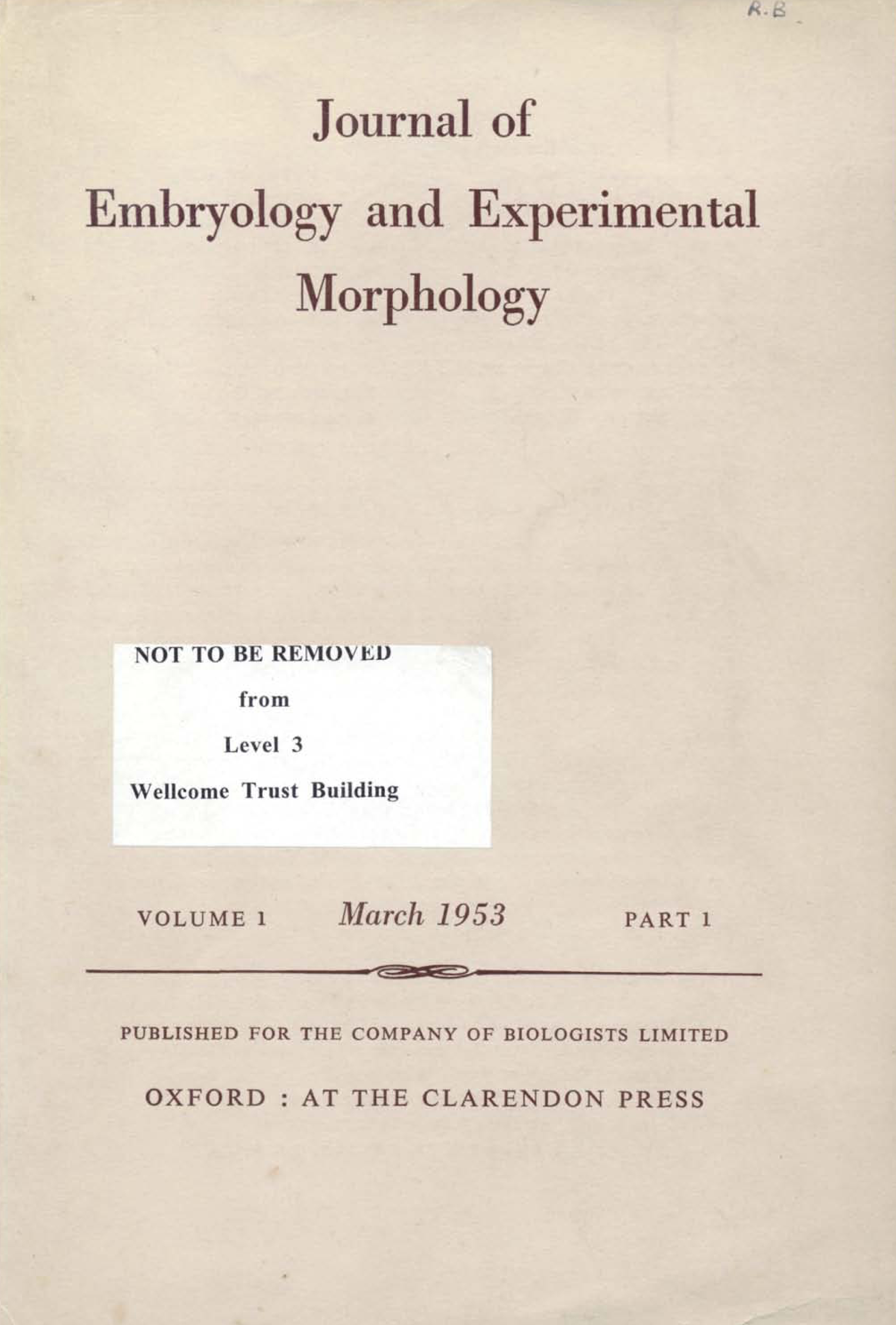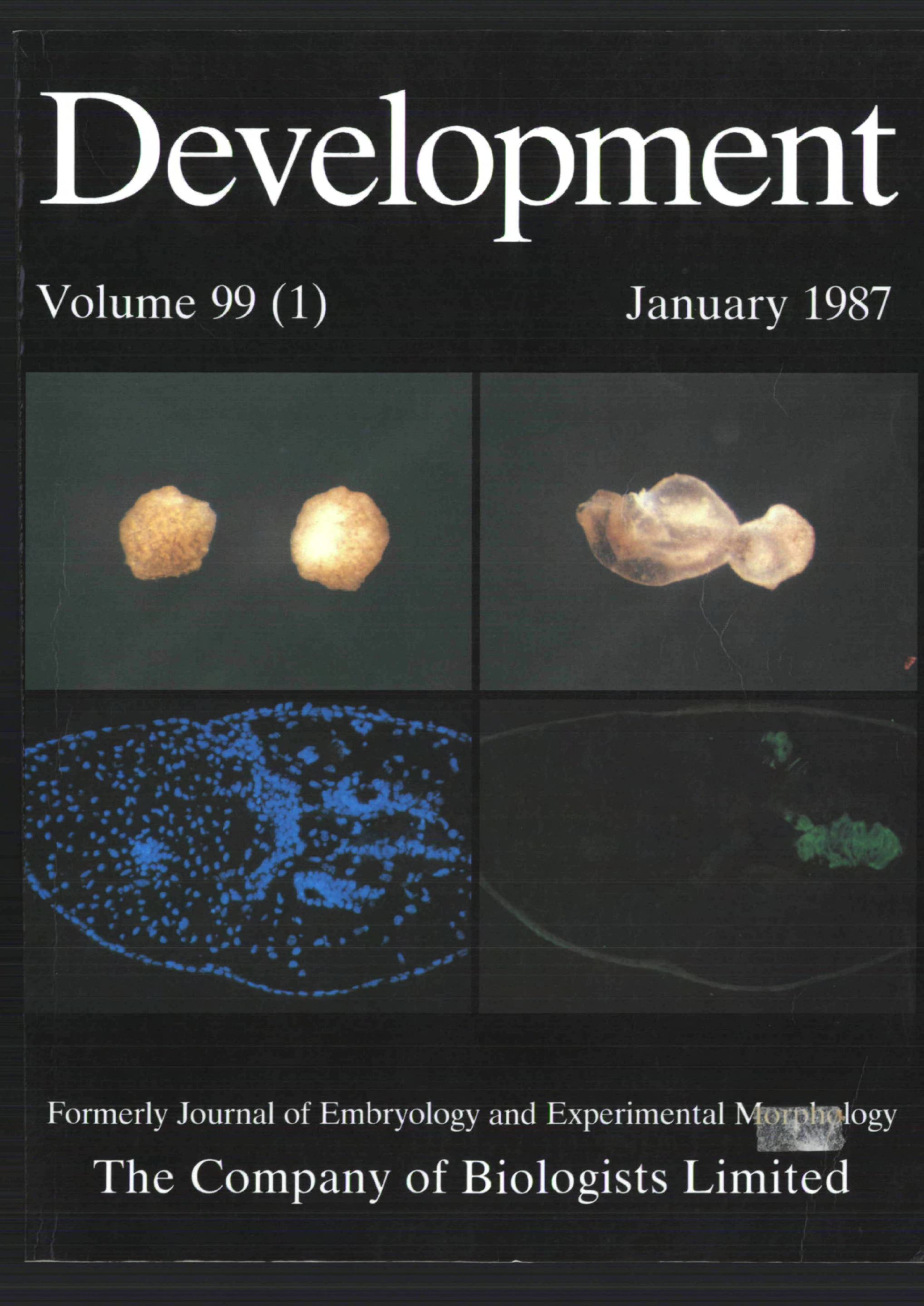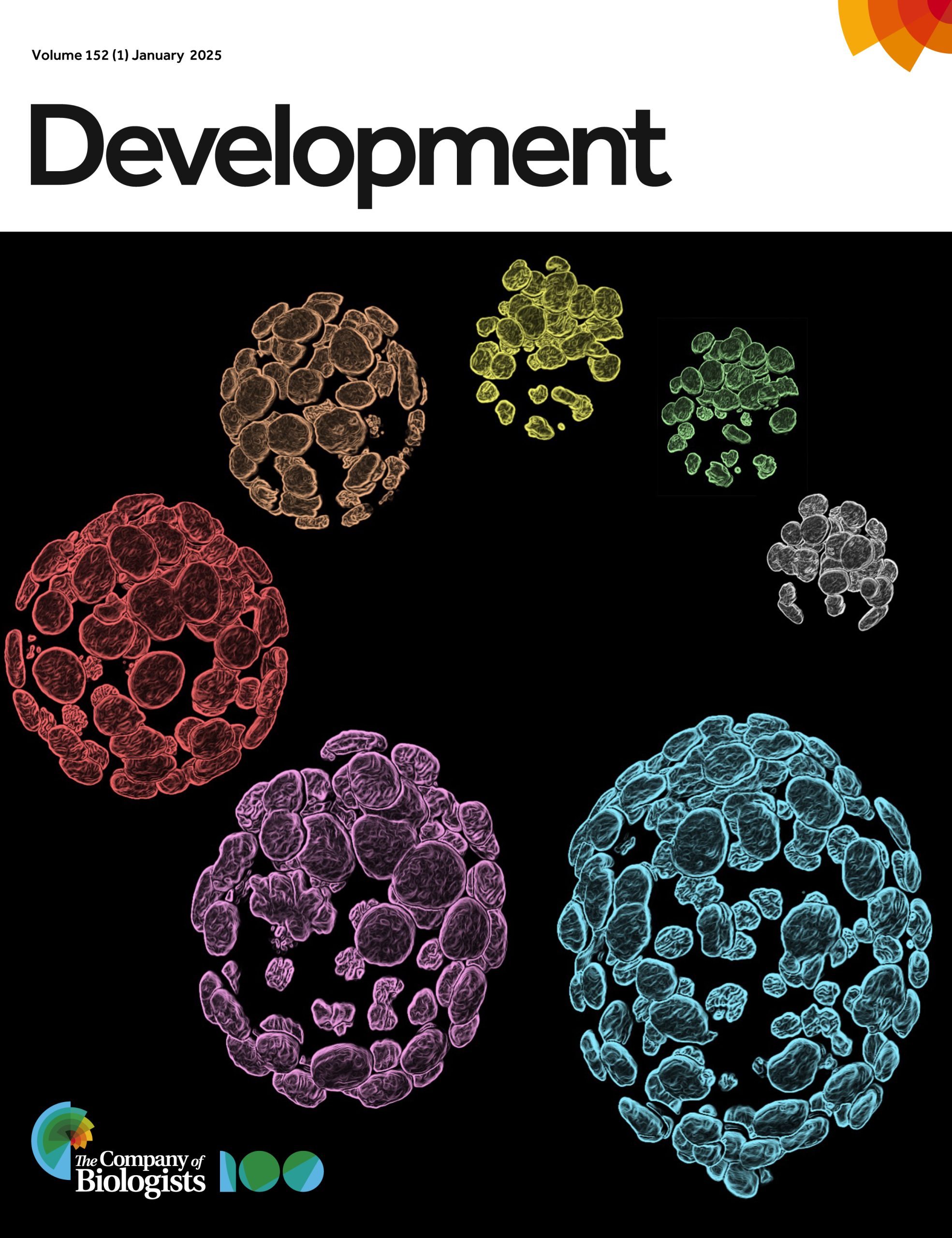First issues – publishing developmental biology through the decades
Posted by Alex Eve, on 10 February 2025
In the latest issue of Development, you can read about the journal’s history since launching as Journal of Embryology and Experimental Morphology (JEEM) in 1953 (Eve, 2025). To complement the Editorial, here on the Node, we compare some ‘milestone’ issues: the first issue of JEEM, the first issue of the journal after being renamed Development in 1987 and the first issue of Development published in 2025, which marks the 100th anniversary year of the journal’s publisher, The Company of Biologists (Bray et al., 2025). Inspired by our colleagues at Journal of Experimental Biology (Hankins and Rutledge, 2023), we look at how changing publishing trends have evolved through the decades, all from the perspective of the table of contents. In addition, some of Development’s in-house team will highlight papers of their choice published in the first issue of JEEM or Development over the week, with a short series of vignettes about the authors and their research. We hope you find the series interesting and that you enjoy learning a little more about the people who’ve contributed to the journal during its history.
A comparative approach
Table 1 summarises some of the statistics from the three issues. Let’s first acknowledge that journal articles vary widely from one issue to the next, so examining a single issue isn’t representative of overall trends in biology or publishing. So, for example, just because the three issues selected here don’t contain an article from India doesn’t mean the journal never publishes work from Indian researchers (indeed, we do!) or that India doesn’t have a flourishing developmental biology community (indeed, it does!). However, this minimalistic approach helps highlight some potential leads for further discussion.
 JEEM Volume 1, Issue 1 |  Development Volume 99, Issue 1 |  Development DevelopmentVolume 152, Issue 1 | |
|---|---|---|---|
| Year published | 1953 | 1987 | 2025 |
| Format | Online | ||
| Total number of articles | 7 | 13 | 17 |
| Number of research papers | 6 | 13 | 10 |
| Number of other articles | 1 article: 1 Foreward | 0 | 7 articles: 2 Research Highlights, 1 Editorial, 3 interviews, 1 Review |
| Average number of authors per research paper (authors/papers) | 1.83 (11/6) | 2.15 (28/13) | 5.1 (51/10) |
| Estimated gender ratio of research paper authors (men:women)* | 6:5 (approx. 1:1) | 21:7 (3:1) | 32:19 (approx.1.5:1) |
| Research paper author location by country | 4 countries: Denmark (3 authors), France (5 authors), the Netherlands (2 authors), UK (1 author) | 4 countries: Canada (3 authors), Germany (5 authors), Japan (1 author), UK (10 authors), USA (9 authors) | 7 countries: China (14 authors), France (1 author), Japan (10 authors), Poland (1 author), Spain (4 authors), UK (8 authors), USA (8 authors) |
| Number of species featured | 12 species: catshark, chicken, frogs (3 species), newts (2 species), Planarians (5 species) | 8 species: chicken, frogs (2 species), Hydra, moth, mouse, rat, Tetrahymena | 6 species: C. elegans, cricket, Dictyostelium, Drosophila, mouse, zebrafish |
| Number of languages used in research papers | 2 (English and French) | 1 (English) | 1 (English) |
| Academic Editorial team | 1 member: 1 Editor | 8 members: 1 Editor-in-Chief; 7 Editors | 21 members: 1 Editor-in-Chief, 13 Editors, 5 Associate Editors, 2 Guest Editors |
| Ratio of Editors (men:women) | 1:0 | 8:0 | 11:10 (approx. 1:1) |
| Editor location by country | 1 country: UK (1) | 2 countries: UK (6), USA (2) | 7 countries: Canada (1), France (1), Germany (1), Japan (1), Switzerland (1), UK (6), USA (10) |
| Editorial Board members | 23 | 48 | 107 |
| Estimated gender ratio of Editorial Board members (men:women)* | 21:2 | 38:10 (approx. 3:1) | 71:36 (approx. 2:1) |
*We’ve had to estimate when authors or members provide only forename initials or have names that do not identify gender. We also acknowledge that some individuals may not identify as a man or a woman, but we cannot always determine them by name alone.
Trends in papers
One important trend that is seen across the publishing industry is that there are more authors per paper (Jakab et al., 2024). In the 1950s, when JEEM was launched, it was common – standard, even – to have publications with just one or two authors. This pattern is still true in the 1980s when Development was (re)launched but, occasionally, papers with several authors do crop up. Today, single-author research papers from the field of developmental and stem cell biology are very rare. Two-author papers are still seen, although there aren’t any of these in the first issue of 2025; it’s much more common to see papers with at least three authors. Issue 1 of 2025 also contains a couple of papers with 10 contributing authors, which I don’t think would surprise any readers. The increasing number of authors likely reflects the increasing content per paper; comparing a research article published today from one 70 years ago, it’s clear that more experiments, techniques and models are employed today, all of which can be complex and require time, money and expertise (see later posts in this series, as well as the Regeneration retrospective and Forgotten classics series). More authors are also evidence of the strong collaboration culture that exists in today’s science.
Over the years, there’s also been an increase in the geographical range of authors. JEEM was founded as a developmental biology journal for European research to complement the launch of Embryologia in Japan, so it’s no surprise that the papers in its first issue derive from European authors (Medawar, 1980). However, as a UK-based journal, it’s a little unexpected to see only one paper from the UK in this inaugural issue; looking at the first volume, there are a few more papers from British authors in later issues, as well as papers from the USA and India. UK-based authors are well represented in the first issue of Development, possibly because of the strong links between the journal and the British Society for Developmental Biology established by this point (Eve, 2025). Part of the discussion around the rebranding of the journal as Development considered the need to capture more papers from North America as a research powerhouse, reflected in more authors from Canada and the USA in the first issue – as well as the appointment of two USA-based Editors (Eve, 2025). In 2025, Development has a global reach and publishes papers from developmental and stem cell biologists worldwide. The increasing research output from Asia is illustrated by increasing numbers of papers and authors based in China and Japan, although publications from the UK and USA still make large contributions.
In early issues of JEEM, there was no such thing as a model organism; researchers used all sorts of species, things they could dredge from ponds (Pasteels, 1953), find under rocks (Brøndsted, 1953) or fish during trips to Naples (Van de Kamer and Schuurmans, 1953). Not a single article in the first issue of JEEM uses mice, although it is worth pointing out that in vitro systems (of chick cells, in this case) are represented (Wolff et al., 1953). By the first issue of Development, the field had coalesced around a handful of model systems for which there were genetic tools and large research communities, including papers from giants in the field, such as Jim Smith using Xenopus (Smith, 1987) and Rosa Beddington and Patrick Tam using mice (Beddington and Tam, 1987). The first issue of Development also features studies on moths, which shows how the journal has always supported developmental biology regardless of the experimental system (Kato et al., 1987), which remains true today – see the latest Special Issue: Uncovering Developmental Diversity. Table 1 also highlights the prominence of zebrafish papers in modern issues of Development, gaining popularity since the genetic screens were published in the ‘zebrafish issue‘ of the journal in 1996. Interestingly, the two issues of Development here feature articles on protists, Tetrahymena (Frankel and Nelsen, 1987) and Dictyostelium (Yamashita et al., 2025), which we can probably consider outliers! Plant models don’t appear in these three specific issues, although Development publishes many plant papers. In fact, when JEEM was first launched, the press suggested that ‘animal’ was added to the journal’s title, but the journal’s Editor, Michael Abercrombie, opposed this addition because it would ‘preclude the journal from ever accepting papers [that] integrate botanical and zoological aspects of the subject’ (The Company of Biologists’ Board minutes). However, it was when the journal was renamed Development in 1987 that it started actively inviting plant papers. Similarly, human models, including stem cells and organoids, although absent in this selection, are now frequently seen in Development following active recruitment of the papers as part of Olivier Pourquie’s tenure as Editor-in-Chief (Eve, 2025) – although early volumes of JEEM also contain studies on primary human tissue (e.g. O’Rahilly, 1963).
Trends in the journal
The organisation and management of the journal have also evolved alongside the papers it publishes. When JEEM was launched, Michael Abercrombie was the only (UK-based) Editor who handled research papers. The number of Editors expanded up to a team of four during the following decades, all of whom were located within Britain. As I mentioned earlier, a key focus at the time of Development’s launch was receptivity to research from the USA, and so the British team was supported by two new USA-based Editors (Eve, 2025). This year, Development has Editors from North America, Europe and Asia, which better represent the research community.
In addition to geographical range, the journal has improved its team’s gender diversity over the years. Although there was one Editor for the first issue of JEEM, there was an Editorial Board (which can support Editors with making decisions on specific papers or general journal strategy) of 23 members – only two of whom were women. Although one might argue there were fewer women in leadership positions in the 1950s, the gender of the authors published in the same issue is almost 50–50, indicating the Editorial Board is not representative. Gender balance is better in the first issue of Development, with a ratio of three men to one woman on the Editorial Board, the same as the authors. However, the eight-person Editorial team is 100% men! Now, the team at Development is roughly equal, with 11 men and 10 women Editors, which much better represents our society, and an Editorial Board of two men for every woman, which is in line with that of authors and suggestive of representing the field.
One aspect of the journal that has become less diverse over the years is language. Many articles in JEEM are written in French (e.g. Pasteels, 1953) and some other languages, such as German (e.g. von Gerhart Wagner), are also present. Although I don’t know if he was a polyglot himself, Abercrombie was a proponent for multilingual science, introducing a practice that all papers must have dual-language abstracts, frequently reporting to the publisher the number of articles published in each language, as well as the journal eventually providing some translation services to authors (Gurdon, 2013; The Company of Biologists’ Board minutes). This policy was slowly phased out between 1960-1970 as English became the de facto language for research communication.
Finally, as already alluded, the journal has expanded hugely during its lifetime to keep up with rapidly increasing research output. From a single Editor in JEEM, Development now has 21 Editors handling research papers. Similarly, the Editorial Board has roughly doubled from 23 in JEEM’s first issue to 48 in the first issue of Development and then doubled again to 107 in the journal’s current volume. The number of research papers published has remained largely stable, but modern Development supports these with a strong ‘front section’ featuring review-type articles and magazine-type content, such as interviews and perspectives, which is handled by an in-house team.
If you’re interested in learning more about the science published in these first two issues, check back again tomorrow!
References
Bray, S. J., Royle, S. J., Shiels, H. A. and St Johnston D. (2025). The Company of Biologists: celebrating 100 years. Development; 152 (1): dev204567. doi: https://doi.org/10.1242/dev.204567
Brøndsted, H. V. (1953). Rate of Regeneration in Planarians after Starvation. Development; 1 (1): 43–47. doi: https://doi.org/10.1242/dev.1.1.43
Eve, A. (2025). Development: a journal’s journey. Development; 152 (3): dev204602. doi: https://doi.org/10.1242/dev.204602
Frankel, J. and Nelsen, E. M. (1987). Positional reorganization in compound janus cells of Tetrahymena thermophila. Development; 99 (1): 51–68. doi: https://doi.org/10.1242/dev.99.1.51
Gurdon, J. B. The cloning of a frog. Development; 15 June 2013; 140 (12): 2446–2448. doi: https://doi.org/10.1242/dev.097899
Hankins, L. E. and Rutledge, C. E. (2023). Class of 1923: looking back at the authors of JEB’s first issue. J Exp Biol; 226 (1): jeb245424. doi: https://doi.org/10.1242/jeb.245424
Jakab, M., Kittl, E. & Kiesslich, T. (2024). How many authors are (too) many? A retrospective, descriptive analysis of authorship in biomedical publications. Scientometrics; 129, 1299–1328. https://doi.org/10.1007/s11192-024-04928-1
Medawar, P. B. (1980). Michael Abercrombie, 14 August 1912 – 28 May 1979. Biogr. Mems Fell. R. Soc.; 261–15. http://doi.org/10.1098/rsbm.1980.0001
O’Rahilly, R. (1963). The Early Development of the Otic Vesicle in Staged Human Embryos. Development; 11 (4): 741–755. doi: https://doi.org/10.1242/dev.11.4.741
Pasteels, J. (1953). Les effets de la centrifugation sur la blastula et la jeune gastrula des Amphibiens: I. Mécanisme de la formation des organes secondaires aux dépens de l’ectoblaste. Development; 1 (1): 5–24. doi: https://doi.org/10.1242/dev.1.1.5
Smith, J. C. (1987). A mesoderm-inducing factor is produced by a Xenopus cell line. Development; 99 (1): 3–14. doi: https://doi.org/10.1242/dev.99.1.3
Tam, P. P. L and Beddington R. S. P. (1987). The formation of mesodermal tissues in the mouse embryo during gastrulation and early organogenesis. Development; 99 (1): 109–126. doi: https://doi.org/10.1242/dev.99.1.109
Van de Kamer, J. C. and Schuurmans, A. J. (1953). Development and Structure of the Saccus Vasculosus of Scylliorhinus caniculus (L.). Development; 1 (1): 85–96. doi: https://doi.org/10.1242/dev.1.1.85
von Gerhart Wagner. (1955). Chimaerische Zahnanlagen aus Triton-Schmelzorgan und Bombinator-Papille: Mit Beobachtungen über die Entwicklung von Kiemenzähnchen und Mundsinnesknospen in den Triton-Larven. Development; 3 (2): 160–188. doi: https://doi.org/10.1242/dev.3.2.160
Wolff, E., Haffen, K., ;Kieny, M. and Wolff, E. (1953). Essais de cultures in vitro d’organes embryonnaires en milieux synthétiques. Development; 1 (1): 55–84. doi: https://doi.org/10.1242/dev.1.1.55
Yamashita, K., Shimane, K. and Muramoto T. (2025). Optogenetic control of cAMP oscillations reveals frequency-selective transcription factor dynamics in Dictyostelium. Development; 152 (1): dev204403. doi: https://doi.org/10.1242/dev.204403



 (2 votes)
(2 votes)
I published two papers from my doctoral thesis in JEEM in 1968 – on nervous system development in zebrafish – this was long before they had become a “model organism” !
Ahead of the curve indeed!